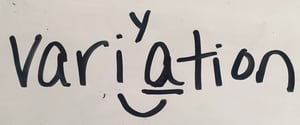Spotlight on /y/ and /w/
What are the Y and W symbols doing at the top of the Color Vowel® Chart? They're here to quietly remind us and our learners about vowel-to-vowel linking, both within words and between words.
English speakers automatically insert these special sounds both between words and within words:
Between words: see(y)it, do(w)it
Within words: vari(y)ation, situ(w)ation
Dr. Robin Barr, Linguist in Residence at American University, explains:
“Though you can’t tell from the spelling, English is a language that hates putting two vowel sounds together.”
Take, for example, the word variety. Our eyes tell us that the <i> and the <e> in variety represent two vowel sounds in a row.
Our ears, however, know the real story: that the second and third syllables in variety are linked with a /y/: variYety . You can think of these as 'invisible sounds' — sounds that you can hear but don’t see indicated in the spelling of the word.
Why on earth do we have these invisible sounds? Barr explains: The so-called tense vowels of English (color vowels GREEN, GRAY, BLUE, and ROSE) all are really diphthongs rather than steady-state vowels (at least in most dialects, excepting, for example, the Minnesota/Wisconsin “o”). This is an automatic (subconscious) rule, so most native English speakers don’t realize they turn these vowels into diphthongs. But the movement is easiest to hear as linking between two words, when the diphthong ends the first word and the next word begins with a vowel.
Examples of “invisible sounds” /y/ and /w/:
- “See it” –> seeYit
- “She almost” –> sheYalmost
- “Do it” –> doWit
- “Go away” –> goWaway
To teach vowel-to-vowel linking using The Color Vowel® Chart, stand to the right side of the chart and use your hand to illustrate the dynamic movement of each sound. In this way, your hand will mimic the actual movement of the tongue (for /y/) or lips (for /w/).
Demonstrating the phrase “see it,” point to GREEN while saying “see,” then move up to the /y/ as you link to “it,” swiftly moving your hand down to SILVER.
When English learner speech sounds ‘choppy’, it is often because the learner isn't linking enough. Instead, they may be inserting a glottal stop (represented by “?” in the examples below):
- See ? it
- Say ? it
- Do ? it
- Go ? away
Glottal stops are exactly 'wrong,' but they have their own purpose. Native speakers will subconsciously use glottal stops either to clarify/emphasize the message or to indicate strong emotion such as frustration or anger.
- Go ?aWAY!
Other learners may be omitting one of the two vowel sounds, so that one ‘swallows up’ the other (where “see it” becomes “seet”), or otherwise distorting the rhythm that English listeners expect, making them hard to understand.
Some teachers find it difficult, at first, to notice and teach vowel-to-vowel linking, so let’s practice:
Example #1: situation
- Working with the word situation, identify and locate the first of the two vowel sounds. (In situation, it would be the sound represented by the letter “u,” and that sound is BLUE.)
- Say the word situation through the second syllable, lingering on the BLUE sound located at the letter “u” and touch BLUE on the Color Vowel™ Chart.
- Then, using your hand as as guide, swing up to the watermark /w/ shown above the upper right corner of the Chart, and demonstrate the way BLUE naturally moves toward /w/
- Finally, anticipating the second of the two vowel sounds, swing down and over to what is the stressed vowel sound. (In situation, you’ll swing over to GRAY, lengthening the time on that GRAY to convey stress: situ(w)ation
Example #2: variation
- Working with the word variation, identify and locate the first of the two vowel sounds. (In variation, it would be the sound represented by the first letter “i,” and that sound is GREEN.)
 Say the word variation through the second syllable, lingering on the GREEN sound located at the letter “i” and touch GREEN on the Color Vowel™ Chart.
Say the word variation through the second syllable, lingering on the GREEN sound located at the letter “i” and touch GREEN on the Color Vowel™ Chart.- Then, using your hand as as guide, swing up to the watermark /y/ shown above the upper left corner of the Chart, and demonstrate the way GREEN naturally moves toward /y/. (It’s a rather subtle movement that many native speakers are unaware of, but it is an important feature of the GREEN vowel sound)
- Finally, anticipating the second of the two vowel sounds, swing down to what is the stressed vowel sound. (In variation, you’ll swing down to GRAY, lengthening the time on that GRAY to convey stress: vari(y)ation
- The image below illustrates the three main steps.
Vowel-to-vowel linking is a wide-spread feature of spoken English, yet many learners can study for years without even noticing it. Teaching vowel-to-vowel linking through visual and kinesthetic channels helps learners notice it and, in time, master these important “invisible sounds.”
Dr. Robin Barr is Linguist In Residence at American University in Washington D.C. She uses The Color Vowel Chart to teach phonetics and pronunciation teaching methods.
Karen Taylor is co-author of The Color Vowel Chart. She is constantly aware of (and delighted by) her own use of /y/ and /w/ for vowel-to-vowel linking.

.png)